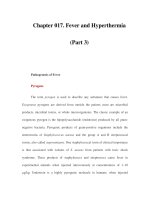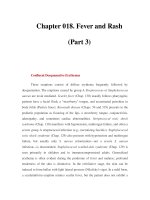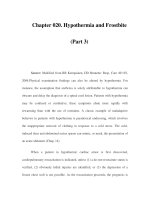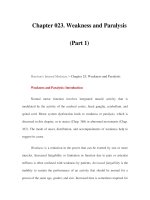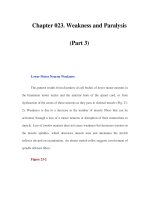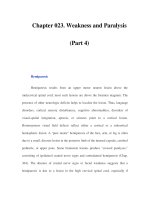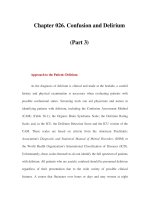Chapter 040. Diarrhea and Constipation (Part 3) pps
Bạn đang xem bản rút gọn của tài liệu. Xem và tải ngay bản đầy đủ của tài liệu tại đây (47.75 KB, 5 trang )
Chapter 040. Diarrhea and
Constipation
(Part 3)
Colonic Motility and Tone
The small intestinal MMC only rarely continues into the colon. However,
short duration or phasic contractions mix colonic contents, and high-amplitude
(>75 mmHg) propagated contractions (HAPCs) are sometimes associated with
mass movements through the colon and normally occur approximately five times
per day, usually on awakening in the morning and postprandially. Increased
frequency of HAPCs may result in diarrhea or urgency. The predominant phasic
contractions in the colon are irregular and nonpropagated and serve a "mixing"
function.
Colonic tone refers to the background contractility upon which phasic
contractile activity (typically contractions lasting <15 s) is superimposed. It is an
important cofactor in the colon's capacitance (volume accommodation) and
sensation.
Colonic Motility after Meal Ingestion
After meal ingestion, colonic phasic and tonic contractility increase for a
period of ~2 h. The initial phase (~10 min) is mediated by the vagus nerve in
response to mechanical distention of the stomach. The subsequent response of the
colon requires caloric stimulation and is mediated at least in part by hormones,
e.g., gastrin and serotonin.
Defecation
Tonic contraction of the puborectalis muscle, which forms a sling around
the rectoanal junction, is important to maintain continence; during defecation,
sacral parasympathetic nerves relax this muscle, facilitating the straightening of
the rectoanal angle (Fig. 40-1). Distention of the rectum results in transient
relaxation of the internal anal sphincter via intrinsic and reflex sympathetic
innervation. As sigmoid and rectal contractions increase the pressure within the
rectum, the rectosigmoid angle opens by >15°. Voluntary relaxation of the
external anal sphincter (striated muscle innervated by the pudendal nerve) in
response to the sensation produced by distention permits the evacuation of feces;
this evacuation process can be augmented by an increase in intraabdominal
pressure created by the Valsalva maneuver. Defecation can also be delayed
voluntarily by contraction of the external anal sphincter.
Figure 40-1
DIARRHEA
Definition
Diarrhea is loosely defined as passage of abnormally liquid or unformed
stools at an increased frequency. For adults on a typical Western diet, stool weight
>200 g/d can generally be considered diarrheal. Diarrhea may be further defined
as acute if <2 weeks, persistent if 2–4 weeks, and chronic if >4 weeks in duration.
Two common conditions, usually associated with the passage of stool
totaling <200 g/d, must be distinguished from diarrhea, as diagnostic and
therapeutic algorithms differ. Pseudodiarrhea, or the frequent passage of small
volumes of stool, is often associated with rectal urgency and accompanies IBS or
proctitis. Fecal incontinence is the involuntary discharge of rectal contents and is
most often caused by neuromuscular disorders or structural anorectal problems.
Diarrhea and urgency, especially if severe, may aggravate or cause incontinence.
Pseudodiarrhea and fecal incontinence occur at prevalence rates comparable to or
higher than that of chronic diarrhea and should always be considered in patients
complaining of "diarrhea." Overflow diarrhea may occur in nursing home patients
due to fecal impaction that is readily detectable by rectal examination. A careful
history and physical examination generally allow these conditions to be
discriminated from true diarrhea.
